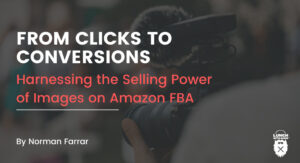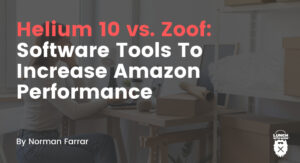Top Amazon FBA KPIs for Sellers: Metrics That Matter | Forum Brands
- Forum Brands
Do you know your Amazon seller metrics?
Also known as Amazon Key Performance Indicators (KPIs), these are the metrics an eCommerce seller can use to gauge its progress towards its stated goals. They are measurements of your success (or lack thereof) and can be used as a rangefinder that steers you towards your intended target, whether it be acquiring new customers, getting selected for the buy box, or preparing your brand for acquisition.
But with scores of relevant KPIs, what are the most essential Amazon performance metrics, and why do they matter? This eCommerce performance metrics guide is for you.
What Are Amazon FBA KPIs?
The world of eCommerce is incredibly complex and in constant flux. To achieve objective success, you need a clear understanding of your business’s performance.
Amazon FBA KPIs are quantifiable measurements that a retailer can use to judge the company’s performance in relation to its stated goals. Equipped with this historic data, companies can make informed, data-driven decisions toward achieving their aims concerning any number of business focuses, including:
- Sales campaigns
- Logistics
- Customer support
- Marketing
- Advertising
Why Do Amazon KPIs Matter?
Chances are, your business is spending its finite resources on various strategies in the hopes that they help your brand grow.
But how do you know if they’re making an impact? How do you measure the cost-benefit?
With so many moving pieces, it’s hard to determine which objectives are the most important. Simply having dozens of KPIs isn’t all that useful if they’re not meaningful. In fact, they can distract from those that require immediate attention. But as Lydia Vargo, VP of Global Strategic Accounts at ChicExecs, notes, if you focus on the right ones, they can:
- Act as a business report card
- Help you reach your long-term goals
- Warn you to pivot before it’s too late
- Identify profitable opportunities
- Uncover trends and patterns
- Motivate you to improve processes
- Measure employee performance
Running an Amazon business can get confusing with so many moving parts and can be difficult to determine the effectiveness of marketing and growth tactics for amazon sellers. That’s why having an Amazon key performance indicator dashboard or using Amazon advertising and marketing KPIs are critical for success.
But what are the eCommerce KPIs brands should be monitoring?
We suggest you limit your efforts to the rule of four within two spheres—financial KPIs and operational KPIs.

Rule of 4—Financial KPIs
Financial key performance indicators are high-level measurements of a company’s fiscal performance in relation to factors like revenue, expenses, and budgets. To that end, our four financial eCommerce KPIs include:
#1 Sales Growth ($)
Sales revenue is the fundamental basis KPI that impacts an eCommerce brand’s bottom line. But revenue in and of itself is not actionable—not without a trend line to provide meaningful perspective.
Revenue figures must therefore be compared to historical data and then weighted according to previous expectations. With that, you can see whether you’re trending upward, downward, or simply treading water.
Are your sales increasing absolutely? If so, that indicates that the company has momentum. But it also could mean that there are untapped opportunities.
#2 Contribution Margin (%)
This Amazon KPI is the selling price per unit minus the variable cost of each unit. It has a formula of C = P – V. And, in the world of eCommerce, it represents the profits before marketing and total advertising cost.
The contribution margin is the incremental money gained from every SKU sold online once the variable portion of costs has been deducted. It signals how much weight that Amazon product has in relation to your overall profits.
If you want to perform a break-even analysis, you’ll need to calculate your contribution margin.
#3 EBITDA (%)
Your earnings before interest, taxes, depreciation, and amortization (EBITDA) eschew non-operating factors to create a snapshot of your eCommerce store’s short-term operational efficiency. This Amazon KPI is the “health” metric for a brand’s P&L.
EBITDA allows you to compare your company to brands with differing tax profiles, operating budgets, and debt. It also quantifies earnings attributable to operations.
Ideally, you should seek to achieve a margin of 10% or higher.
#4 Free Cash Flow ($)
Positive cash flow isn’t automatically a signal that your brand is financially healthy.
Free cash flow is your cash on hand once operational expenses and capital investments have been paid and accounted for. This shouldn’t be confused with net profit, since it doesn’t account for the cost of goods sold, including taxes.
What can you do with FCF? It signals the following:
- A brand’s ability to pay out dividends
- A brand’s ability to repay debt or take on future debt
- A shift in business trends
FCF is also a critical component of a discounted cash flow (DCF) analysis, which is one of the more useful measurements for ascertaining an investment’s potential.

Rule of 4—Operational KPIs
How efficiently is your company performing its day-to-day work?
Operational KPIs can help measure the productivity of your organization. To keep a finger on the operational pulse, you must pay special attention to the following four key performance indicators:
#1 Impressions (#)
Impressions are the number of times your brand was the result of an Amazon or Google search.
As a top-of-the-funnel metric, this quantifies your brand’s visibility and consumer reach. Each impression represents an opportunity to surprise and delight consumers.
#2 Market Share (%)
How much of the market do you control?
Your market share is the portion of sales within a specified market divided by the total market size.
Naturally, this is one of the more useful KPIs for measuring your competitive execution and potential for future growth. However, it’s important to note that it’s almost always an estimate since the total market size is constantly changing and often unmeasurable.
#3 ROAS/MROI (#)
Return on ad spend and marketing return on investment are metrics that help you evaluate the success of an advertising campaign or your overall marketing strategy. They are the productivity metric that drives a brand’s P&L. This performance metric can be calculated by utilizing the Amazon Vendor Central and Amazon Seller Central ad interfaces.
Using these figures, you can identify the strategies that are working and those that are coming up short. Then, lean into the ones that are providing ROI.
#4 Availability Rate
The availability rate, also known as the out of stock rate, is the foundational measurement of a brand’s consistency and shapes the entire consumer experience.
Proper inventory management is essential to continued eCommerce success. Having too much stock on hand isn’t necessarily a positive, since every unit takes up valuable shelf space. But having too little—so much so that you’re consistently running out—could mean you miss out on a sudden demand spike or create an inconsistent customer experience.
Like cash flow, it’s important to identify and then operate within the goldilocks zone.

Mastering Your Brand’s KPIs
To strategically grow an eCommerce business, you’ll need data—and lots of it. Armed with Amazon sales metrics, you can drill down into the financial and operational KPIs that matter most. By tracking, managing, and evaluating key metrics, you’ll be able to position your business for an eventual sale.
Are you at the point where you’re ready to sell your Amazon FBA business?
At Forum Brands, our mission is to acquire budding eCommerce businesses and grow them into global brands. When you partner with us, we guarantee a close in 30 days or less, tech-driven support, and continued resource support to grow your business acumen.
What would a sale look like? Contact us today.
Sources:
Forbes. Why You Still Need Strategic KPIs To Reach Your Goals In 2022. https://www.forbes.com/sites/forbesbusinessdevelopmentcouncil/2022/03/28/why-you-still-need-strategic-kpis-to-reach-your-goals-in-2022/?sh=3cec4c4a6499
Investopedia. What Exactly Does the EBITDA Margin Tell Investors About a Company? https://www.investopedia.com/ask/answers/042415/what-exactly-does-ebitda-margin-tell-investors-about-company.asp
Forum Brands is the world’s most technology-driven e-commerce operating platform. Using its proprietary technology and data science, Forum buys Amazon FBA businesses in categories that consumers love and builds them into leading omnichannel brands. Forum provides entrepreneurs with efficient and lucrative opportunities to sell their business. Entrepreneurs share in the upside as Forum builds a long-term legacy for the brand they built from scratch. The team brings expertise from Amazon, Target, McKinsey, TA Associates, Cove Hill Partners and more. Forum Brands is backed by world-class investors including Norwest Venture Partners, TriplePoint Capital, NFX, and Concrete Rose, and is headquartered in New York, New York. For more information, please visit forumbrands.com.








